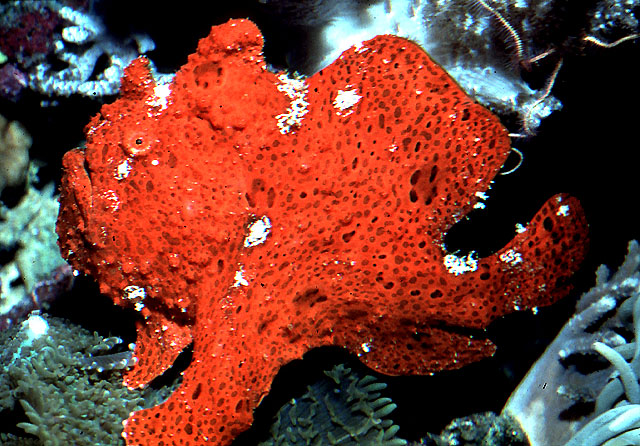| Antennariidae (Frogfishes) |
| 45 cm TL (male/unsexed) |
|
reef-associated; marine; depth range 0 - 70 m |
| Indo-Pacific and Eastern Pacific: Red Sea and South Africa (Ref. 4113) to Panama, north to southern Japan and the Hawaiian Islands, south to the Lord Howe and the Society islands. Referred to as Antennarius moluccensis by authors. |
|
Dorsal spines (total): 3-3; Dorsal soft rays (total): 12-13; Anal spines: 0-0; Anal soft rays: 8-8. Comes in a variety of colors: yellow, orange, green, brown, and black. Bony part of illicium about equal to length of the 2nd dorsal spine (10.2-16.9 %SL); esca a small tuft of flattened appendages (Ref. 4538). Illicial length in %SL: 19.3-25.2 (Ref. 6773). Membrane behind 2nd dorsal spine thick and spinulose, extending to base of third (Ref. 6773). One of the largest species (Ref. 48635).
Description: Characterized by being densely mottled or with spots, blotches or striations; partially or fully covered with low, rounded wart-like swellings on head and body (Ref. 90102). |
| Found in lagoon and seaward reefs (Ref. 9710), often on jetty (Ref. 48635). Benthic (Ref. 58302). Feed on fish (Ref. 11889) and small shrimps (Ref. 89972). Oviparous. Eggs are bound in ribbon-like sheath or mass of gelatinous mucus called 'egg raft' or 'veil' (Ref. 6773). Solitary and frequently among sponges in 1-50 m, usually less than 20 m (Ref 90102). |
|
Least Concern (LC); Date assessed: 30 April 2021 Ref. (130435)
|
| harmless |
Source and more info: www.fishbase.org. For personal, classroom, and other internal use only. Not for publication.
